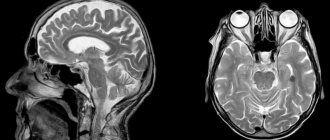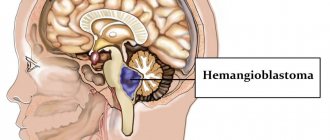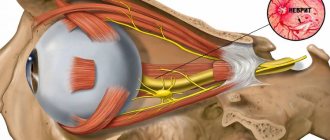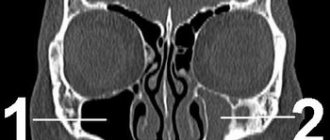- When is Morton's neuroma surgery performed?
- Diagnosis and preparation for surgery for Morton's neuroma
- How does the surgical treatment of Morton's neuroma proceed at the Gelenk Clinic?
- Which surgeon operates on Morton's neuroma?
- What type of anesthesia is offered to the patient before Morton's neuroma surgery?
- Postoperative period, rehabilitation treatment and aids after surgery for Morton's neuroma
- Will I feel pain after Morton's neuroma surgery?
- What are the conditions of stay at the Gelenk Clinic?
- What should you pay attention to after surgical treatment of Morton's neuroma?
- What is the cost of foot surgery?
- How to make an appointment with a doctor and surgery for Morton's neuroma?
Morton's neuroma (red) as swelling between the metatarsal bones (blue).
Irritation of the nerve (yellow) develops a burning and stabbing pain throughout the area of its supply. © Dr. med. Thomas Schneider Morton's neuroma is a benign thickening of the nerves in the metatarsal area. The consequence of the disease is shooting, burning and stabbing pain in the plantar region, as well as in the toes (metatarsalgia). The pain is so severe that the patient experiences relief and improvement in general condition only when he sits down and takes off his shoes. Thus, when the patient is not wearing shoes, the pain goes away much faster. In addition, characteristic symptoms of Morton's neuroma are tingling or numbness in the toes. Morton's neuroma is a common consequence of transverse flatfoot, sometimes accompanied by hallux valgus. Women suffer from Morton's neuroma much more often than men. The reason for this is most likely due to different fashions for shoes: High heels, as well as shoes with pointed toes, put strong pressure on the front arch of the foot and can provoke the appearance of transverse flat feet. As a result of this pathology, the position of the metatarsal bone changes in the patient and the pressure on the nerves passing along the plantar region of the foot increases.
Morton's neuroma is also diagnosed in men, most often in those who engage in high-volume running sports. Morton's neuroma is often observed between the 3rd and 4th toes, and less commonly between the 2nd and 3rd toes.
send a request
When is Morton's neuroma surgery performed?
In order to correctly assess the patient’s condition and prescribe the correct treatment, Gelenk Clinic specialists will need to provide current MRI results. Based on the MRI images, the doctor determines the degree of need for surgical treatment of Morton's neuroma. If there are certain indications, the patient is prescribed the best surgical technique for him.
In the early stages, treatment of the disease is carried out using conservative methods, namely special insoles and gymnastic exercises for the feet. If the quality of life is significantly limited, and if the patient experiences severe pain despite conservative treatment, the doctor will refer him for surgery. If the thickening is 0.8 cm in size, a nerve-sparing operation (neurolysis) is performed. If the swelling of Morton's neuroma is greater than normal, the nerve is removed through neurectomy.
Prevention
Morton's neuroma is a disease whose development can be avoided by following simple rules. First of all, prevention of the formation of thickening of the intermetatarsal nerve consists of:
- wearing narrow high-heeled shoes only on special occasions and for a short period of time;
- preference for comfortable shoes as the main ones;
- prevention of flat feet, which consists of performing a special set of exercises, including rolling a ball with the foot and lifting small objects from the floor with the toes;
- performing a foot massage;
- weight control and maintaining it at optimal levels;
- timely treatment of orthopedic disorders;
- refusal to engage in traumatic sports;
- rational loads on the lower limbs;
- timely diagnosis and treatment of foot injuries;
- prevention of the development of atherosclerosis and other vascular disorders, which is mainly achieved through a healthy diet and rational physical activity.
Thus, Morton's neuroma is a harmless, but extremely unpleasant disease, the development of which is much easier to avoid than to then deal with its consequences. Treatment of pathology in the early stages can be carried out using conservative methods, but without correcting habits and footwear it will not be successful. The most reliable and effective method of combating already formed Morton's neuroma is surgery. Modern techniques make it possible to radically solve the problem of pain in less than an hour and return a person to the ability to move without pain. At the same time, operations of this kind are associated with minimal risks of complications, do not require long and complex rehabilitation, and also allow you to return to most everyday activities the very next day after the procedure.
Diagnosis and preparation for surgery for Morton's neuroma
Clinical examination of Morton's Neuroma using a provocative test (Mulder test): A foot specialist diagnoses the disease by compressing the heads of the metatarsal bones and simultaneously palpating the intermetatarsal spaces, which causes pressing pain. © joint-surgeon
Alternative Causes of Forefoot Pain
- Inflammation of the joint located between the bones of the metatarsal and proximal phalanges
- Nerve damage
- Stress (stress fractures) of the metatarsals
- Changes in soft tissue structure, including scars, warts and tumors
- Incorrect weight distribution, as in the case of severe flat feet
Before starting treatment for Morton's neuroma, the doctor conducts a full clinical and imaging diagnosis, which includes a preliminary conversation, physical examination, and MRI with contrast. During magnetic resonance imaging, the patient is in the “lying on his stomach” position, and during the x-ray in the “standing position”. In order to determine how the pressure is distributed under the plantar part of the foot, a podometric study (pedobarography) is carried out at the Gelenk Clinic. Based on the results obtained, the doctor discusses the upcoming operation with the patient.
If the patient’s health condition does not prevent surgical treatment, the operating doctor tells the patient in detail about the course of the operation and also explains possible complications. In addition, you will be referred to an appointment with an anesthesiologist, who will re-analyze the results of the studies and determine whether your condition allows the administration of anesthetics. As a rule, Morton's neuroma surgery takes place the next day after agreement with the operating surgeon and anesthesiologist.
What is Morton's neuroma
The foot is built in such a way that a thin metatarsal bone leads to each toe; their heads, together with the phalanges of the toes, form the metatarsophalangeal joints. In the immediate vicinity of the metatarsal bones, intermetatarsal nerves pass, branching into 2 branches in the area of the interdigital space. Each of these branches is responsible for transmitting nerve impulses to the lateral surfaces of neighboring fingers. In the area of the metatarsal heads, the interdigital ligament passes, touching the intermetatarsal nerves.
Morton's neuroma is a thickening of the intermetatarsal nerve sheath at the site of its division into 2 branches innervating two adjacent toes. Since it is located in close proximity to the heads of the metatarsal bones and the transverse ligament of the foot, these structures are capable of compressing the thickened nerve during walking and other types of physical activity, which leads to pain of varying degrees of intensity.
But the name of the disease does not accurately reflect its nature and essence. The concept of neuroma is widely used in oncology to describe tumors of the nerves, but in this case we are not talking about the formation of a tumor, and therefore the pathology has nothing to do with malignant processes. Since the formation of Morton's neuroma is accompanied by the formation of a thickening of the nerve, which can even be felt upon palpation, historically it came to be called a neuroma. The name has taken root in medicine, although it would be more correct to call this pathology Morton’s metatarsalgia.
Morton's neuroma is also called perineural fibrosis, intermetatarsal neuroma, plantar neuroma.
Morton's neuroma is one of the diseases accompanied by the development of carpal tunnel syndrome. In essence, it is a benign thickening of the nerve, formed as a result of thickening of its sheath and the formation of a connective tissue sheath around it. It was found that its dimensions can be 0.15-0.65 cm in width and 0.95-1.45 cm in length, i.e. the thickening has an elongated, spindle-shaped shape.
Most often, young women suffer from this pathology, and damage to the nerve trunk of only one of the feet is usually observed, although the development of a bilateral process is also possible. In most cases, the thickening is located between the 3rd and 4th toes, where the painful lump occurs. Somewhat less frequently, it forms in the 2nd interdigital space and very rarely in the 1st and 4th, i.e., at the big toe and little toe. Since the branches extending from the affected nerve innervate the lateral surfaces of the corresponding fingers, pain when irritated by the thickening tends to radiate to them.
Interestingly, Morton's neuroma almost never occurs in children. Their similar symptoms are usually caused by metatarsal fractures or metatarsophalangeal joint dislocations.
Thus, Morton's neuroma does not pose a threat to life, but can significantly reduce its quality, making it difficult to lead an active lifestyle and perform everyday tasks due to severe pain in the feet and fingers. Due to the resulting limitations in mobility, patients experience serious physical and psychological discomfort, which should not be tolerated. The possibilities of modern medicine make it possible to get rid of constant pain in the foot and restore the patient’s joy of life and movement.
How does the surgical treatment of Morton's neuroma proceed at the Gelenk Clinic?
Surgery makes sense if conservative treatment, for example, orthopedic insoles, special shoes with butterfly soles, foot exercises, as well as injections of local anesthetics and self-massage do not help relieve pain for a long time. Gelenk Clinic mainly uses two treatment methods: nerve-sparing neurolysis and nerve removal. Each operation lasts about 30 minutes.
Ventral view of the foot: Morton's neuroma is located between the 2nd and 3rd toes. Most often, pathology occurs between the 3rd and 4th fingers. © Viewmedica
Nerve-sparing minimally invasive surgery for Morton's neuroma
Mechanical pressure on the plantar area of the foot leads to pinched nerves. Due to nerve irritation, the connective tissue sheath of the plantar nerve swells and forms scar tissue. There is an accumulation of fluid.
As a result of the swelling, ischemia occurs and the nerves of the foot are no longer supplied with nutrients. Because of this, the patient develops such characteristic complaints as a feeling of numbness, shooting pain and itching (pins and needles) in the foot. Relieving mechanical pressure on the nerve may relieve these symptoms to a certain extent.
The optimal treatment for many compression syndromes (eg, carpal tunnel syndrome) is nerve decompression. If the Morton's neuroma is less than 0.8 cm in size, nerve-sparing surgery is performed
Using the technique of stress relief and, if necessary, decompression of the nerve by repositioning the metatarsal bone, the specialists of our clinic have been achieving excellent results for several years. In particular, Gelenk Clinic has a good record in preventing relapses. Recurrence of the pathology is more likely after nerve amputation (neurectomy), since this operation does not correct the original violation of the arch of the foot. Despite this, neurectomy is the standard treatment for Morton's neuralgia. Too often, for Morton's neuralgia, the plantar nerve is removed without first testing the effectiveness of nerve-sparing treatment.
Advantages of nerve-sparing surgery:
Nerve-sparing endoscopic treatment of Morton's neuroma with a superior approach instead of the conventional plantar approach has the following advantages:
- less scarring and therefore little irritation of the foot nerves
- the risk of hematomas is reduced
- preservation of the plantar nerve, which after complications will stop hurting and return to its original functions
- reduction in relapse rate: due to the reappearance of painful swelling, relapse is not uncommon
- decreased tendency to form painful scars in the area of the metatarsal nerves
Neuroctomy - removal of the inflamed nerve
During this surgery, diseased nerve tissue from the tibial nerve is removed. At the Gelenk Clinic, neurectomy is performed in cases of severe swelling of Morton's neuroma. That is why this surgical treatment requires a preliminary MRI examination, which helps doctors determine the size of the disease. Since slice-by-slice images obtained using magnetic resonance imaging sometimes do not provide complete information about the size and location of Morton's neuroma, the exact technique is chosen directly during surgery after analyzing and examining the thickening.
With surgical access to Morton's neuroma through the head of the metatarsal bone, decompression can be relatively performed, that is, the degree of compression can be reduced. This method of treatment is an appropriate accompanying surgical procedure, since reducing compression reduces the likelihood of relapse, that is, secondary rupture of the stump of the damaged nerve, resulting in swelling of the connective tissue. Surgery for Morton's neuroma with a superior approach avoids scarring on the sole of the foot. This speeds up the wound healing process, and the patient can resume putting weight on the foot a little earlier.
Competencies
Morton's neuroma
- Reasons for development
- How the disease develops
- Symptoms
- Diagnostics
- Consequences of the disease
- Treatment
Morton's neuroma is a pathology that is characterized by the appearance of a fibrous formation on the foot in the area of the plantar nerve. The disease has other names: Morton's finger syndrome, interdigital neuroma, perineural syndrome. They are all synonyms. Neuroma occurs in both women and men. However, women still get sick more often, especially in mature and old age - after 45–50 years.
Reasons for the development of the disease
The risk of developing Morton's toe syndrome is caused by several factors that negatively affect the tissues of the foot.
These include:
- Traumatic injuries of the foot, accompanied by compression of nerve formations in the interosseous space;
- Transverse flatfoot, which deforms the foot and disrupts its normal innervation;
- Hematomas (soft tissue bruises) pressing on the nerve;
- Chronic infections affecting the tissues of the foot;
- Obliterating diseases of the legs that interfere with blood supply;
- Prolonged physical activity with the patient constantly in a standing position (for example, at work);
- Obesity, which gradually leads to foot deformation and compression of the plantar nerve.
Also, the shoes worn by the patient play a big role in the development of Morton's neuroma. You should not buy constricting, uncomfortable shoes and boots - this leads to disruption of the blood supply and innervation of the tissues of the foot.
As you can see, perineural fibrosis can be caused by many unrelated causes. Only an experienced surgeon can determine what exactly causes the disease and how to cure it.
How does Morton's neuroma develop?
Most often, Morton's neuroma develops in the space between the third and fourth toes - the third intermetatarsal space. The disease is usually unilateral. In rare cases, with rapid onset and early progression of perineural fibrosis, neuroma can form on both sides.
The main pathological factor in the development of the disease is excessive pressure exerted on the bones of the foot. The bones become deformed and change position, causing the plantar nerve to be compressed. An inflammatory process develops around the damaged tissues, which ends with the active growth of connective tissue in the area and its fusion with the bones and muscles of the foot. The fibers that make up the plantar nerve degenerate and form so-called growth flasks, as well as Perriconcito spirals. The normal innervation of the foot is disrupted.
Symptoms
Morton's neuroma is characterized by a specific set of symptoms:
- Pain.
Aching, at first it occurs only after physical exertion or long walking, then the discomfort intensifies significantly, and the periods of absence of pain are reduced. The presence of night pain is not typical for Morton's disease. Most often, discomfort is localized between the 3rd and 4th toes, but sometimes it can spread to the entire foot. - Itching and burning in the affected area.
Symptoms are associated with disruption of the nerve innervation of the foot. - Unpleasant sensations when wearing shoes.
The patient feels discomfort, as if some object was shoved into his shoe that is not actually there.
Morton's disease is characterized by a slow onset. Over time, the signs of the disease intensify, and the disease increasingly interferes with the patient’s ability to walk normally. In severe cases, symptoms of the pathology can also occur at rest, when the patient does not move for a long time.
A characteristic sign of perineural fibrosis is the absence of foot deformities that are visible to the naked eye. The slightest displacement of the bones is enough to compress the nerve. In this case, outwardly the leg will look completely normal, changes are noticeable only at the microscopic level.
Diagnostics
A surgeon diagnoses Morton's neuroma. The patient’s complaints are of great importance - the patient needs to be told in as much detail and clearly about the symptoms as possible. The doctor also pays special attention to the medical history. The patient needs to remember when he felt the first signs of pathology, when they intensified, and how their severity changed over time. It is important to determine under what circumstances pain appears - during strong and prolonged physical activity or during small ones. This will help you understand how severely the plantar nerve is affected.
To clarify the diagnosis, the doctor conducts a local examination of the foot with palpation of its surface. When compressed, pain is clearly defined, localized in the area of the third intermetatarsal space. The appearance of numbness of the fingers during palpation in this area also indicates the presence of Morton's neuroma in the patient. There should be no external changes on the foot; bone deformation indicates the presence of concomitant pathologies or an incorrect preliminary diagnosis.
Often, to exclude other diagnoses, the patient is prescribed an X-ray examination, in which all bone formations are clearly visible. If the doctor has doubts about the nature of the disease, he sends the patient for an MRI. This technique makes it possible to visualize the soft tissues of the foot.
To determine the exact location of perineural fibrosis, local anesthetics are injected into the affected area. If the pain suddenly disappears, then the pathological focus is identified correctly. Based on all the data obtained during the examination, the doctor makes an accurate clinical diagnosis and prescribes surgery to remove Morton's neuroma.
Consequences of the disease
With timely consultation with a doctor and proper treatment, the prognosis for the patient is favorable. But if the patient does not pay attention to the alarming symptoms or completely ignores them, Morton's disease will progress over time. Strong physical exertion will become unbearable for the patient, he will not be able to walk for a long time. You can also forget about playing sports. Such consequences can be avoided if you consult a doctor when the first symptoms appear. The doctor will select the right therapy and, if necessary, prescribe surgical treatment.
Treatment of Morton's neuroma
Treatment of Morton's finger syndrome can be either conservative or surgical. Only a large complex of therapeutic procedures will help the patient get rid of an unpleasant disease.
The extent of treatment depends on the severity of symptoms and the stage of the disease - the doctor determines how to treat Morton's neuroma, taking into account various factors.
Conservative treatment
In the early stages of Morton's neuroma, the patient usually does not require surgery. The syndrome can be cured with conservative therapy, the main goal of which is to reduce pressure on the arch of the foot and ease the load on the bone formations.
For mild cases of the disease, it will be enough to follow a number of rules:
- Choose comfortable, soft shoes that fit well and don’t squeeze your feet. Preferably with a flat sole;
- Buy special orthopedic insoles;
- Reduce the load on the foot - walk less, avoid prolonged standing;
- Do a foot massage daily.
By following these recommendations, a patient with a mild form of neuroma can quickly get rid of pain and discomfort in the legs.
To treat Morton's finger syndrome, analgesics that block pain are actively used:
- Nimesulide;
- Diclofenac;
- Solpadeine;
- Codelac.
Physiotherapeutic treatment is of great importance in conservative therapy. This may be electrophoresis of the affected area, the use of diatoks, laser, or electromagnetic radiation. During the rehabilitation period, after the exacerbation of Morton's disease has stopped, the patient is recommended to perform a special set of physical therapy exercises aimed at restoring normal activity of the limbs.
Unfortunately, conservative treatment for Morton's neuroma is not always effective. In most cases, surgery cannot be avoided.
Surgery
Surgical treatment is necessary when the pathology is in advanced stages and its conservative therapy does not produce results.
Doctors identify several ways to eliminate Morton's finger syndrome:
- The simplest method is ectomy (removal) of the neuroma. The surgeon makes an incision in the interdigital space, finds the affected nerve and removes the resulting formation. After this, he places interrupted sutures on the surface of the wound and removes them two weeks after the operation.
- The second method involves releasing (cutting) the transverse metatarsal ligament. This leads to the fact that the compression of the nerve disappears and the innervation is restored. At the same time, the integrity of the nerve itself is also preserved, which is very important in the treatment of the disease.
- Osteotomy is rarely used. During the operation, the bone is carefully sawed in a strictly defined place. This relieves compression of the plantar nerve. This method is also called an artificial fracture.
After removal of Morton's neuroma, a period of rehabilitation begins. During this time, the patient should limit all stress on the legs, wear only comfortable shoes without heels and avoid hypothermia of the foot.
In severe cases of pathology, radical surgery is required, in which the inflamed area of the foot is simply excised. Such intervention is carried out very rarely, only if there are strict indications.
Many sites advise ways to treat Morton's neuroma using traditional medicine methods at home. Unfortunately, we have to admit that such treatment is ineffective. Various tinctures and ointments can eliminate symptoms and relieve pain, but the disease itself will not disappear and will steadily progress.
Without proper treatment, the prognosis for the patient is disappointing. You should not ignore the symptoms of the disease, otherwise you will have to deal with serious consequences. Morton's disease is a complex pathology with a constantly progressive course. Therefore, if symptoms appear, be sure to schedule a preventive examination with your doctor.
Which surgeon operates on Morton's neuroma?
One of the features of the Gelenk Clinic is the trusting relationship between doctors and patients. That is why your attending physician will take care of you from the first examination until the operation itself. This way you will have a specialist whom you can contact at any time convenient for you. The Gelenk Clinic's highly qualified experts in the field of foot and ankle surgery are Dr. Thomas Schneider and Dr. Martin Rinio. Also, Dr. Schneider and Dr. Rinio are certified specialists who are annually audited by the independent German Association of Foot and Ankle Surgeons (German DAF) for advanced training, diagnostics and quality of operative activities. That is why the Gelenk Clinic Orthopedic Medical Center has the honor of being called the Specialized Center for Foot and Ankle Surgery (ZFS).
Why is surgery needed?
If treatment is not carried out in a timely manner, the disease can cause acute, shooting pain, which worsens every day and leads to limitation of limb movements. It makes it impossible to take a step or play sports; even special orthopedic shoes will no longer help relieve pain.
Often, women are very patient with pain and do not pay attention to them; they come for help after a month or even more, when it is no longer possible to carry out conservative and simple surgical treatment due to insufficient effectiveness.
Therefore, do not forget that the longer you delay treatment of the disease, the more you aggravate the process and quality of life in the future.
In addition, you cannot self-medicate, since using folk remedies - ointments, creams, lotions - can aggravate the course of the disease, and this can result in disability due to loss of motor function.
What type of anesthesia is offered to the patient before surgery?
Typically, surgical treatment of Morton's neuroma is performed under general anesthesia. If the patient refuses this method for personal reasons, there is the possibility of using spinal anesthesia. To do this, the surgeon injects an anesthetic into the spinal canal of the lumbar spine. In this case, the patient is fully conscious. What type of anesthesia is most suitable for the patient is determined during a conversation with the anesthesiologist. Our anesthesiologists are true masters of their craft, who during your appointment will offer you the best method that meets all the indicators of previous examinations.
Preparation and diagnosis of the disease
Diagnosis of Morton's neuroma is as follows:
- collecting anamnesis of life, illness, complaints;
- examination and palpation of the affected limb;
- purpose of laboratory research methods - general blood test, biochemical blood test;
- the appointment of instrumental diagnostic methods - radiography of the foot, ultrasound of the lower limb, CT, MRI with and without contrast.
After conducting all the necessary studies and consulting other specialists, the doctor can differentiate and confirm the diagnosis and choose the correct surgical tactics.
Will I feel pain after Morton's neuroma surgery?
Every operation is associated with some pain—and Morton's neuroma surgery is no exception. As a rule, we try to reduce pain after Morton's neuroma surgery to a minimum. That is why pain treatment begins already during the operation. In most cases, the anesthesiologist will administer a special injection that will numb the foot for about 30 hours. After this, the pain decreases significantly and the patient’s treatment continues with conventional medications. The main thing for us is to ensure a painless postoperative period.
Clinical examination
Patients with symptoms of classic Morton's neuroma experience pain when pressure is applied at the base of the fingers (Figure 3). Additionally, continuous pressure on the forefoot can make symptoms worse. Patients may also experience numbness on the sides of one or both fingers, as this corresponds to the distribution of the nerve involved (Figure 4).
Rice. 3: Common location of pain Fig. 4: Distribution of the nerve involved
What are the conditions of stay at the Gelenk Clinic?
Private ward at the Gelenk Clinic in Gundelfingen, Germany.
© joint-surgeon During your stay at the Gelenk Clinic, you are usually in a separate room, which has a shower and toilet. In addition, we provide towels, bathrobes and slippers. You can also use a safe and minibar. All rooms are equipped with TV. You only need to take medications, comfortable clothes and nightwear with you. Patient care is provided around the clock. The medical staff and physiotherapists at Gelenk Clinic will always answer all your questions. Generally, the length of hospital stay is 3 days. Your relatives can stay at a nearby hotel. Our staff will be happy to take care of your room reservation.
Carrying out the operation
The Department of Surgery at GMS Hospital performs excision of Morton's neuroma, an inflamed area of the foot. This is one of the most effective and safe methods of modern treatment. During surgery, you will not feel pain, and afterward you can quickly return to your previous life.
Progress of the operation:
- preparation of the surgical field, skin treatment;
- local anesthesia;
- a small incision is made between the third and fourth metatarsal bones (usually up to 2 cm);
- immobilization, excision of neuroma;
- layer-by-layer sutures;
- applying a sterile dressing.
You can go home immediately after the operation, the duration of the rehabilitation period on average takes from 2 to 4 weeks, depending on the severity and course of the disease.
Sutures are removed in the surgery department 12–14 days after the operation. During this time, you will visit the doctor to change the dressing. The postoperative wound must be kept clean, dry and monitored for progress in the healing process and restoration of motor function of the limb.
You have questions? We will be happy to answer any questions Coordinator Tatyana
What should you pay attention to after surgical treatment of Morton's neuroma?
Immediately after surgery, the foot should be elevated. To avoid pain and swelling, apply a cooling compress to the foot. After about 10 days, the stitches are removed. After this you can take a shower again.
You also receive special shoes that take the load off the forefoot and transfer the body weight to the heel. If you are planning long walks, you should also take elbow crutches. Prevention of thrombosis during the impossibility of full weight bearing on the foot is necessary. This will prevent dangerous blood clots from forming. Physiotherapy and lymphatic drainage prevent muscle loss and swelling of the forefoot. The duration of forefoot swelling often depends on the age of the patient.
- Inpatient treatment: 2 days
- Recommended length of stay in the clinic: 5-6 days
- When can you fly home: 3 days after surgery
- When is it recommended to buy a return ticket: 5 days after surgical treatment
- When is it permissible to shower: after 10 days
- Length of stay on sick leave: 5 days
- When is it recommended to remove stitches: after 10 days
- Outpatient physical therapy
- When can you drive again: in 4-5 weeks
- Sports activity: at least 6 weeks after surgery
Treatment
Non-surgical treatment
Non-surgical treatment can be quite effective, although it requires more time than surgical treatment.
Non-surgical treatment includes the following:
- wearing comfortable shoes
- use of a gel insert that reduces the load on the forefoot.
- reducing activity, which will reduce or eliminate those activities that increase pain. For example, avoid prolonged standing or other activities that place stress on the forefoot.
- local anesthesia can reduce inflammation associated with the nerve.
Steroid injections may temporarily reduce symptoms. Additionally, it was previously hypothesized that injecting alcohol into a nerve would cause controlled death of the nerve and subsequent resolution of symptoms. Currently, there are no successful scientific studies that would show the advantage of this procedure over other standard non-surgical procedures. Additionally, there are concerns that alcohol may cause excessive scarring and damage to other important structures in the area.
What is the cost of foot surgery?
In addition to the cost of surgical treatment for Morton's neuroma, it is worth considering the additional costs for diagnostics, doctor's appointments and aids (eg elbow crutches), amounting to approximately 1,500 to 2,00 euros. If you plan to undergo outpatient physical therapy treatment after surgery, we will be happy to provide you with an estimate of the costs. Information regarding the cost of hotel accommodation and possible additional treatment at a rehabilitation center can be found on the corresponding website.
Possible complications after surgery
Possible complications after surgery include:
- long-term healing of postoperative wounds.
- infection.
- painful postoperative scar (if the incision is located on the plantar side of the foot)
- numbness in the toes.
- stump neuroma (when the nerve grows at the site of the cut, causing symptoms to recur).
- deep vein thrombosis (DVT)
- long-term persistence of edema (2-3 months after surgery)
- pulmonary embolism (PE)
- Persistent pain is quite common, as the nerve may only be part of the cause of the overall symptoms causing it.
- sympathetic reflex dystrophy or complex regional pain syndrome (CRPS). In some cases, the impact on the nerve at the entrance of surgery can lead to the development of a complex regional pain syndrome that can be distressing. Fortunately, such complications are relatively rare.
How to make an appointment with a doctor and surgery for Morton's neuroma?
First of all, to determine the size of Morton's neuroma, as well as to diagnose possible other diseases, foot specialists in Germany will need current MRI images of the foot and X-ray results. Once we receive all the necessary documents, within 1-2 business days we will email you information for patients, as well as a preliminary cost estimate for treatment of Morton's neuroma.
Foreign patients can make an appointment for Morton's neuroma surgery in a short time. We will be happy to assist in obtaining a visa after the advance payment indicated in the estimate has been received into our account. If a visa is not issued, the amount received is returned to you in full.
Due to sometimes long flights, we try to keep the time between the first examination and surgery to a minimum. During outpatient and inpatient treatment of Morton's neuroma, you will be able to use the services of qualified medical personnel who speak several foreign languages (eg English, Russian, Spanish, Portuguese). Payment for a translator (for example, into Arabic) is carried out separately. We also organize transfers, we can book a hotel room, and we will tell you how to spend time in Germany for you and your relatives.
send a request
Symptoms of Morton's neuroma
While the neuroma is small in size, i.e., does not reach 5 mm, it usually does not manifest itself in any way and patients do not even suspect the presence of any problem in the foot. In such cases, pain or a feeling of tightness may appear when putting on uncomfortable shoes and quickly go away after they are removed. Sometimes there is discomfort between the toes after wearing such shoes or a slight tingling sensation.
However, provided that the action of the provoking factors continues, the thickening begins to increase in size, which first leads to the appearance of shooting and aching pain in the area of the 3rd interdigital space. They usually occur after exercise and walking, and may also be accompanied by the development of various sensory disorders, including:
- crawling sensation;
- burning;
- tingling;
- pain of varying intensity arising from mechanical or thermal irritation.
Moreover, Morton's neuroma is characterized by an almost complete absence of any discomfort in the foot at night.
If at this stage of the development of the disease a person does not consult a doctor, and the cause of pain, paresthesia, allodynia and other sensitivity disorders is not established and, accordingly, treatment with lifestyle correction is not carried out, the symptoms of the disease continue to intensify. The frequency and severity of pain, which can become throbbing, gradually increases; the interval between the start of physical activity and the appearance of the first discomfort is observed to decrease. Often, pain syndrome forces a person to take off their shoes and massage the affected area of the foot. This is due to the continued growth of the nerve thickening.
The disease can have a wave-like course, that is, with periods of intensification of symptoms and their temporary subsidence or even elimination. Sometimes manifestations of the disease may be absent even for several years.
In the later stages of pathology progression, when Morton's neuroma reaches large sizes, patients suffer from:
- sharp, burning pain that can occur even at rest and does not depend on the type of shoes the patient wears;
- sensations of the presence of a foreign object in shoes (as a rule, patients talk about the feeling of a pebble getting into their shoes);
- increasing intensity of sensitivity disorders up to its complete loss;
- changes in gait with forced lameness, since it is difficult to step on the affected leg, and the need to frequently stop while walking.
What is characteristic of this disease is the complete absence of external changes in the condition of the foot and the affected interdigital space. In this case, when you press on the area where the thickening of the nerve is formed, the pain increases sharply.
Severe pain syndrome that occurs during physical activity makes it impossible to engage in sports that involve stress on the legs, i.e. running, jumping, dancing, skiing, roller skating, skating, etc. Even normal walking becomes a challenge for people with this pathology .
conclusions
Morton's neuroma is a widespread pathology among women of active age, which, in the absence of adequate treatment, can lead to temporary or even permanent disability due to serious impairment of the functionality of the foot. The relevance of this problem is also determined by the fact that, despite the numerous existing therapeutic approaches, their effectiveness remains insufficient.
In recent decades, shock wave therapy has been considered a very promising, and most importantly safe, treatment option. This method has significant advantages over traditional conservative and surgical approaches. Also, UVT, being a financially accessible technique, can reduce the economic costs of both patients and medical institutions.










